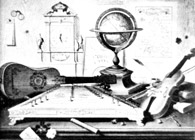
CHAPTER 3: History to 1800
3.5 The Baroque, Rococo and Classical Periods 1600-1800
3.5.1 The west
1.2. Higher cultures in the 17th & 18th centuries: Romance language-area
Documentary evidence: 6 of 14
[138a]
| click! |
 |
| click! |
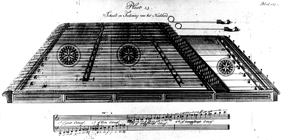 |
Similarly, the drawing of Verschuere Reynvaan shows enough detail to be usable as a construction plan.
An engraving by Danckerts reproduced in Kinsky (p.239) shows a lady, her tympanon laid on a table, playing in concert with lute and flute; bridging of type 11 is suggested, but no details are really discernable.
| click! |
 |
[2008] I don't have access to that picture just now but it sounds like the same subject as in the tile painting by Willem van der Kloet of Amsterdam which Rogério Budasz reproduced in his facsimile, discussed later.
| click! | |
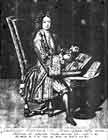 |
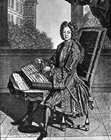 |
| click! | |
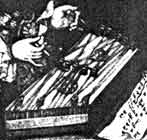 |
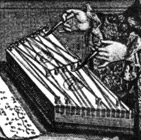 |
Perhaps the surest indication is the positioning of the bass bridges: although these are shown on both sides on the instrument, one row has six bridges, evenly-spaced, while the other has only four, spread about with two single ones near the player, and a pair together at the top. It is likely, then, that the former row is the right-hand bass register, and since the picture which shows this row on the right is that of Trouvain, his may perhaps be the original version: whether Peter Schenk is likely to have omitted the panoramic background in making a copy is another question.
What does perhaps seem more likely is that he would have simplified Trouvain's triple courses rather than that Trouvain would have elaborated Schenk's double ones: since there are no examples of double courses on 17th or 18th century instruments, we will assume them to be triples. The wrest-pins are apparently on the far side of the instrument: if Trouvain's were the correct view, they would be on the right, as is by far the most common.
| click! |
 |
 |
Be that as it may, a considerable amount of detail is shown: the strings number 15 III , grouped as 5 III + 6 III + 4 III, basically a feasible arrangement, although the spacing of the four auxiliary bass bridges is unusual.
The bridges themselves are common enough for the period: the treble and main bass rows consist of chessmen linked by a wire or rod, which we may designate by 'x', while the auxiliary bass bridges are separate chessmen, shown by 'y'; the instrument is trapezoid , shown by '2' as before, and we may use a comma to separate the treble bridge from the bass, so that the classification number for this instrument becomes 1x,1x1y.2. If we take a single letter 'x', to imply 'lx', we may simplify the cipher to 'x,xy.2': note the connection with type 12.2, in which the bridges are arranged in the same way, but are of the continuous type. The nicety of a cover over the hitch-pins is unusual, although common enough on Victorian zithers, and later patented for dulcimers (see Chapter 4).
The way of holding the hammers between the first two fingers corresponds with older illustrations, and with contemporary illustrations of the players of popular instruments, as does the apparent solo nature of the performance, and the placing of the instrument on a table.
The tablature, however, is much more unusual: the problem of hitting a specific string whilst keeping one eye on a page of notes has defeated most players of whatever place and time. The way the sheet of paper curls at the edges is shown slightly differently in the two engravings, and it seems that Trouvain's version has one or perhaps two notes more, at the end of the first line, than does Schenk's - another point in favour of Trouvain's being the original - but on the whole his is a little less clear, at least in my reproduction. Several details obscure the realisation of the tune, notably the 'hair pin' towards the end of the first line: the placing of two musically adjacent notes one above the other (were the notes not discordant, they might have been intended as chords, but perhaps they indicate grace notes, recalling the ligatures of mediaeval notation); and the stroke under the 'a' appearing as the third letter in both the first and second lines. The use of the curved line to suggest the tails of a group of quavers is common enough, however.
|
|